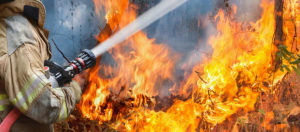According to the Centers for Disease Control and Prevention (CDC), deaths from fires and burns are the fifth most common cause of injury-related deaths in the United States. Now is the time to review your fire safety procedures and ensure that prevention plans are in place.

Fire Alarms and Smoke Detectors
Every institution should have a working fire alarm. These alarms help detect the first inklings of a building fire and are key to preventing death from fire, smoke and hazardous gases. Fire alarms should be installed on every level of the building. It is also beneficial to place the smoke detectors along the escape path from the building to help staff leave safely if visibility is low.
There are several other factors to consider when installing fire alarms, which include:
- Fire alarms should be placed in the center of the ceiling or 6-12 inches below the ceiling if placed on the wall
- Smoke alarm batteries should be replaced twice a year and the alarm itself should be tested every few years and replaced at least every 10 years
- Fire alarms should be tested once a month to ensure they are working properly
Fire Sprinkler Systems
According to the U.S. Fire Administration, the combination of smoke detectors and fire sprinklers lowers the risk of death during a fire by more than 80 percent. Studies by the U.S. Fire Administration have found that fire sprinkler systems can save thousands of lives, reduce fire-related injuries, and prevent millions of dollars in property loss.
Fire Extinguishers
The proper placement of fire extinguishers throughout the facility is a critical element in a fire prevention plan. There are essentially four different types or classes of fire extinguishers, each of which works on specific types of fire. Newer fire extinguishers use a picture/labeling system to designate which types of fires they are to be used on.
As with any mechanical device, fire extinguishers must be maintained on a regular basis to ensure proper operation. The Office of Risk Management has put together a list of approved vendors who can provide a free engineering survey to recommend fire extinguisher placements for your facility.
Space Heaters
In the fall and winter months, some buildings become drafty and cold, causing occupants to utilize space heaters. If using a space heater is permitted, make sure to keep the heater at least three feet away from anything that can burn, such as paper, clothing or furniture. A space heater that automatically shuts off if it tips is recommended.
Electrical Fires
Statistics show that electrical fires cause over 60,000 home fires and close to 500 deaths in the United States each year. December is the most dangerous month for electrical fires. Common causes of these fires include misuse and failed maintenance of appliances, faulty wiring, and overloaded circuits and extension cords.
To prevent electrical fires, please be sure to do the following:
- Use only heavy-duty extension cords for high-wattage appliances, such as freezers and heaters.
- Do not run electrical cords under rugs or trap power cords against walls where heat can build up.
- Check appliances and wiring often and replace worn, old, or damaged appliance cords immediately. Appliances that spark, smoke or overheat should be replaced.
- Have an electrician check light switches that are hot, broken outlets and lights that flicker.
Escape Plans
During a fire, every second counts. In addition to fire alarms, institutions should establish escape plans to help staff leave the building in a timely manner. An escape plan should include at least two ways out of each room in the building. Managers should stress that staff must leave the building immediately once a fire occurs and not re-enter for any reason. Once established, escape plans should be practiced every month to ensure that every staff member is familiar with the most efficient means of egress.
Please take the above precautions for staying safe and educating others regarding fire prevention.

